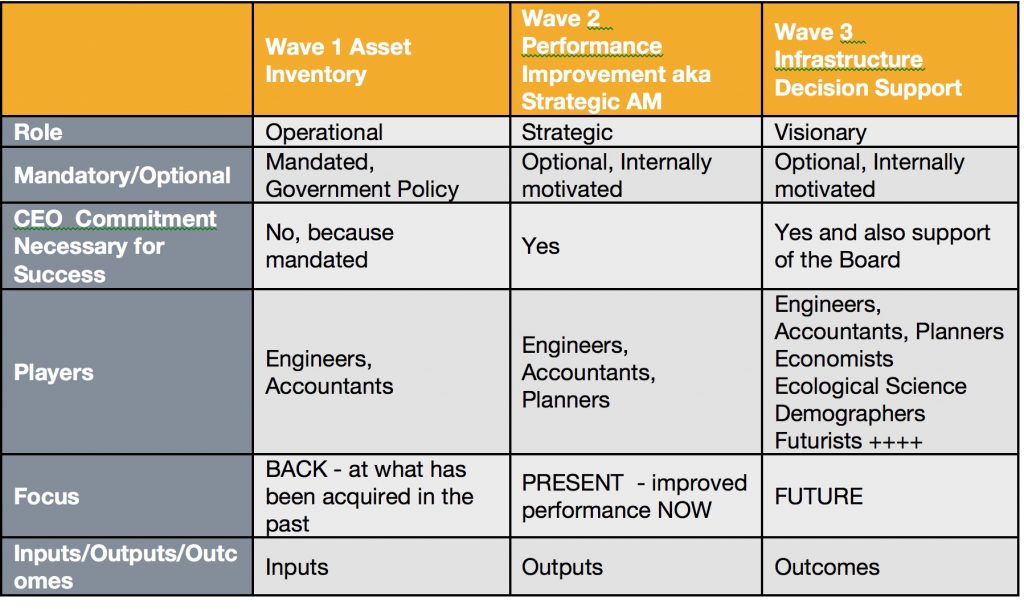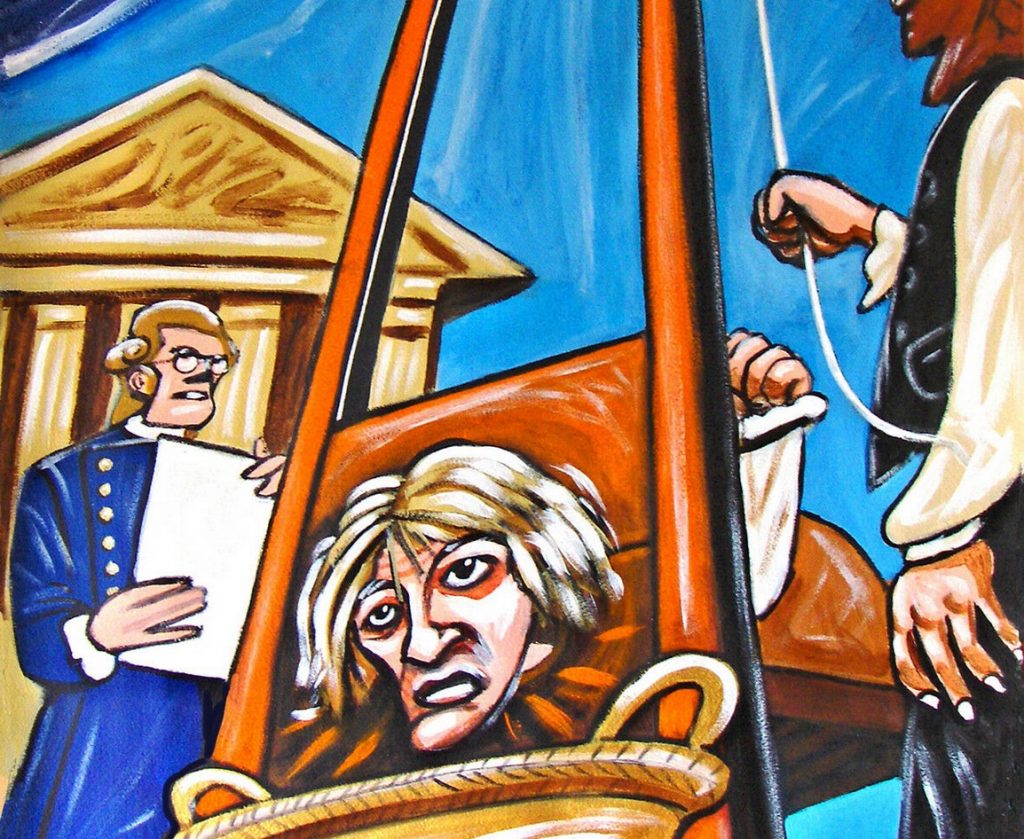
In Australia, interest in asset management arose as the result of a series of eight parliamentary reports in South Australia in 1986/1987 modelling the likely cost and timing of renewing all the State’s major infrastructure assets.
The projected costs were so large that they would have absorbed the State’s total capital budget within the next 10 years if urgent action was not taken. To address this problem, the recommendations in the reports covered possible planning and accounting reforms as well as engineering and maintenance changes.
Following the Public Accounts Committee’s Reports, a major SA Government Task Force was established that reviewed, then agreed and reinforced all the ideas presented in the reports. This led to the formation of a Cabinet sub-committee to consider the issues raised, This provided high level impetus for the development of asset management.
Further support was provided by the Auditors-General who were appalled to find that no public sector department. not even the statutory authorities, had decent asset registers and they made this a requirement.
But the most significant change was that led by the Australian Accounting Standards Board. At this time the board covered accounting standards in both the private and the public sectors. The private sector used commercial standards with accrual accounting but the public sector used cash accounting. The board wanted to standardise on accrual accounting for both but was concerned about how this would be received. When it learnt that the Parliamentary Public Accounts Committee in South Australia was promoting the idea of accrual accounting to better understand and deal with infrastructure asset management, it was encouraged to push ahead. Within two years of the release of the final PAC report, the board had released Exposure Draft 50, the model of accrual accounting for local government.
The introduction of accrual accounting meant that local, state and federal government departments were required to move from their previous practice of simply recording annual cash in and cash out, to establishing balance sheets and recording, for the first time, the depreciated value of their infrastructure and other assets,
You might think that an accounting change would be of no interest to maintenance engineers. Fortunately @Roger Byrne was not your ordinary maintenance manager. He had already been in the habit of including economic and planning issues in briefing notes for his clients and he quickly seized on the opportunity this change presented for maintenance engineers.
It was these briefing notes that later provided the content for the first local government asset management manual which subsequently became the IIMM we all use today. So through top down interest and bottom up capacity building, Australia took an early lead in the development of asset management.
The Parliamentary Reports created a lot of interest Australia wide. No other state was prepared, or even able, to duplicate the research for their own constituency but all infrastructure agencies recognised that the conclusions reached applied as much to them as it did to their South Australian counterparts. The CSIRO’s Engineering and Construction division took an active interest, as did State Treasuries and the Auditors-General.
With these organisations, I continued to develop the ideas that had arisen and, after advising governments, commissions of audit, and infrastructure agencies themselves, I created ‘The Asset Management Quarterly’ publication in 1994 to share with others what I was learning. Then, in 1996, noting that lots of interesting things were being done in the name of asset management – but nothing was being documented, I launched the International Asset Management Competitions where the awards went to the best documentation of good asset management practice. They ran between 1996 and 2000 and in 1998 AMQ International launched the world’s first asset management website with information on asset management freely available to all.
The term ‘asset management’ started to become very popular and everyone wanted to get in on the act. One day, flying from Sydney to Canberra my seat companion described herself as an asset manager – on questioning it turned out that she was actually a real estate developer! Once off the plane and into a taxi, on the taxi radio I heard an advertisement for ‘asset management services’ – which turned out to be office cleaning! Yes, asset management had become the buzzword ‘de jour’.
To be continued….
A REQUEST
I am currently working on a book about our beginnings and would love to speak with anyone about their recollections pre 2014.
Please leave your name below and I will contact you.

Mama
It was 2016 and I was engaged to train Auditors-General in the Pacific area in how to approach infrastructure performance audits. Their audit offices, like their countries, were not well resourced and they could ill afford to waste time and resources. It was important that they focused on the key issues and got their messages across to decision makers. With my colleague, Kerry McGovern, I spent a week in Port Moresby. At the closing party I was honoured with the title ‘Mama’. I thought this was simply a recognition of my age, but no, “mama” meant a wise woman who leads a village. I was enchanted! Who would not want to be wise and lead a village? And is this not what councils do?
So when approached last week to help the UN who are preparing a manual to assist local governments in under-developed countries struggling to adopt AM, I was happy to oblige. I spoke with Kerry and we prepared out ‘top dozen’, as follows.
What needs to be added?
- Build with your own labour and your own local materials. This will ensure you have the skills and ability to maintain what you build.
- Learn to say ‘No’ when donors offer to build something for you with their labour, or to use imported materials when local alternatives are available. Always seek out alternative practices that use local. Welcome financial assistance if, and only if, it strengthens the ability of your own people in the construction, operation and maintenance of the new assets. That is necessary to ensure that the assets will remain functional.
- Prioritise. Do not accept ‘nice to have’ assets, such as sports stadia or entertainment centres, even as donations, if you have more critical requirements in power, water, roads or communications.
- There is no such thing as a ‘free asset’. Every asset costs you. Not only does it require continuous operational costs such as lighting/heating/cleaning, but it will distract the attention of high level decision makers away from other issues.
- ‘Best practice’ and ‘high tech’ can be deceptive. The real ‘best practice’ is the one that you have the skills and abilities to apply over the longer haul. The same for ‘high tech’. The more complicated the technology the more chances are that something will go wrong and that you will be unable to fix it without outside help. And that help may not be available when needed.
- Give your Auditors-General responsibility for auditing the performance of all public infrastructure for both effectiveness and efficiency – and fund and train them in the ability to do so.
- Be clear on what is to be achieved. Assist the Auditors-General by ensuring that all infrastructure proposals – whether with local or donated funds – state clearly the expected outcomes, in addition to cost and time.
- Identify who is going to operate the asset, who is going to maintain the asset – both scheduled maintenance, and unscheduled maintenance and the costs of enabling the operation and maintenance over the entire life of the asset. Then, with that estimate to hand (and preferably arrived at with input from the people who are going to do it) identify the source of funds to pay for all this.
- If using loan funds to pay for the asset, add interest and redemption payments to the operating and maintenance costs. Ensure you factor in the administrative costs of meeting lender requirements, including the cost of training staff to meet them.
- You may need to train workers to operate and manage the asset. Negotiate with the education department to find out what is involved in ensuring a supply of skilled people, able to operate and maintain the asset and administer loans / grants for the asset.
- Consider how the country is going to set up the support systems to enable the asset to function as intended. For example, if a road, what vehicles will be using the road? where will people obtain these vehicles? how will they be maintained and operated? Who will pay for that? What income streams will cover the costs of the asset PLUS using the asset in your country.
- Plan for the safe treatment of waste generated by the asset (in both construction and use – eg. disposal of old cars, mitigation of petrol fumes, unused bitumen, water run off, etc.)
Your suggestions? (add in the comments box below)

Homo Sapiens is a pattern seeking species
it is how we advance. We seek patterns to find meaning. Me, I look for patterns in AM development. I seek the characteristics of the different stages (that I now think of as waves rather than as revolutions, as explained in the last post) and how each builds on the one before and takes us further. This helps me to see not only where we have been but also where we can go. Each wave has its own focus, viewpoint, key players and sources of support as well as constraints. Below is a table illustrating some of the characteristics of the first three waves that I see. What do you think?

Where we have been and where we are
Waves 1 and 2 you will readily recognise, for they reflect where we have been and where we are. Wave 3 is where we need to go next. This is the visioning stage where asset management teams, use their appreciation of ‘line of sight’ or the necessity for asset actions to support organisational objectives to guide decisions on both new and existing infrastructure. This is where AM teams need to anticipate, communicate, and prepare for the inevitable shifts in attitudes, governance and demand, that are now occurring and will continue to occur as demographics, climate and technology change. Turning around large infrastructure portfolios is not an overnight task. It takes intelligent planning and communication. This is Wave 3.
Where we are going
Communication, anticipation, action. In Wave 3 AM teams help their corporate managements to explicitly recognise that the asset portfolios and management practices they have now are a reflection of the past, and that the future will be very different from the past and will involve new thinking. This may seem obvious, but it is not necessarily happening at the moment. Sometimes it seems that it is easier to assume that nothing will change very quickly so we can continue doing what we have always done. And sometimes the lure of the new and shiny leads to adoption of the new without sufficient examination.
The Wave 3 challenge is not to jump straight into the new and exciting, but rather to determine how best to reduce the twin dangers of changing too early, and of moving too late.
The biggest change will require us to ask what changing circumstances and future communities will DEMAND of us, what the new needs will be, and not to look at new technology as merely an opportunity to change the way we SUPPLY the current needs of our customers and community.
From Supply to Demand. In the past most of the information we have needed for our decision making in asset management has been internally generated and recorded in our Asset Information Systems. This has been solely supply side information. We still need our supply side information. But this will not suffice. Knowing what we CAN do is not enough. We need also to look at what we MUST do. For this, we will increasingly require the ability to understand and anticipate future demand change. This is why our our asset management teams will need to expand to include the talents of many other professionals, as I have suggested in the table above.
Is your Asset Management Team prepared?
Is your Asset Management team prepared to tackle the third wave? If you are not sure, then a good place to start would be with “Building an Asset Management Team” by Ruth Wallsgrove and Lou Cripps. This will help you recognise not only requirements but also the many new possibilities. Here is a short excerpt “What kind of people does an AM team require?”
Note: When you buy “Building an Asset Management Team” you not only get the very latest thinking in AM teamwork, but you pave the way for future developments, for Ruth and Lou are donating all their proceeds (ALL, not just profits) to Talking Infrastructure.
So go ahead, click this link to get your copy. You can get a Kindle version for less than $10. In this case value greatly exceeds cost. It’s priced low to maximise the number of teams that can gain access. Spread the word!

I was wrong. Movement from maintenance to asset management, to strategic asset management is NOT a revolution. Why not?
In 2018, for the IPWEA’s online journal, Jeff Roorda and I sketched out what we saw as the general pattern of these individual journeys and what this suggested about where we would go next. At the time there was a lot of discussion about the third (and for some) the fourth industrial revolution. We needed a sexy title for our paper so we called it ‘The third AM Revolution’.
We saw AM moving from the pre-AM stage of maintenance only to the first stage of data collection, or ‘asset inventory’, to the second stage of performance and alignment, or what we call ’Strategic asset management’ – the stage we believe most of Australia is now in – to a new third stage, our ‘third revolution’ that we are calling ‘infrastructure decision support’.
We now see that ‘revolution’ was the wrong word.
Revolutions have connotations of what was previously important getting the chop – quite literally in the French Revolution! Although each of the three stages we identified are still important because they represent different mindsets and approaches, different groups of players and different techniques, they do not discard what went before. Instead they increase our understanding of their value and make them stronger.
Let’s see how that works.
0. Before AM there was maintenance. Maintenance specialists firmly believed in the value of their work, and they were right. Unfortunately they were unable to convince others, especially finance. When AM came along it provided a framework to demonstrate that not only was maintenance able to fix what was currently broken – it could also help prevent more breaking down in the future. That is why so many maintenance engineers were keen to see AM adopted by their organisations.
1. The first stage of AM, naturally, was to establish an asset inventory. We needed to know what we had to manage.
2. With enough basic data we were enabled to take the next step use the data collected for performance improvement. When we did this, we became much more aware of data quality and coverage. That first stage of data collection did not get the chop, now we wanted more. Instead of data being required simply for a mandated balance sheet (e.g. a storage location) it was increasingly seen as necessary, indeed essential for progress, and so demand for more data, and for data of a higher quality with greater coverage has continued.
3. The coming third stage is what will bring all of these stages – maintenance, data collection and performance improvement or strategic asset management – together, for it is at this third stage that asset managers finally reach the stage that they have desired for a long time. Asset management is able to get (and worth a) place at the board table!
So not a revolution. But what?
We could simply call them ‘three stages’ and be done with it. This, however, would not show the connection between them, how each builds on what went previously, so we are calling them waves, for like waves they build on each other and get stronger.
Why is this important?
Because now that it is so easy to access detailed information about the second wave of strategic asset management or performance improvement (IIMM, PAS55, ISO 55,000) there is a temptation is to dive in at this level. But without attention to the first wave of data collection and without strengthening the pre-AM stage of maintenance, such attempts lead to failure. Under-developed countries wanting, and needing, to do fast catch up with the developed world are at particular risk.
They are being pressured ‘to do asset management’ in order to get the strategic asset management, second wave, benefits but the importance of funding and training at the earlier stages, particularly maintenance is not being recognised and dealt with. Every stage – maintenance/pre-AM, data collection/asset inventory, and strategic asset management/performance improvement or alignment – requires a different focus, different tools, different groups of players.
I will talk about Wave 3 – where we go next – in a later post.
Q: Does this development pattern make sense to you?
Can you recognise it in your own organisation or others? Is it obvious, or do you see an alternative pattern to your own asset management journey?
Coming Next: The Three Waves
Why understanding them can help you move closer to your ultimate goal.

Ten years ago, on LinkedIn’s Asset Management History Forum, I asked “Why bother with history?” It was the most animated discussion on the forum. Now, with ten more years of history behind us, have we learnt more or do you agree with Jan Korek’s view that history is irrelevant?
This was Jan Korek’s opening statement:
“I have never subscribed to the suggestion that you need to know where you’ve been, to know where you’re going! History, to me, is little more than a badly-drawn representation of the past, based on an exaggerated impression of successes….. and an amnesia of the failures.
Having been deeply fascinated by Asset Management for a score or more years, and am still working at the blunt edge of the process, I have had to change, adapt, forget much and learn more along the way. So what do practitioners, or the process, gain from a knowledge of when (or why) some obscure government department became notionally interested in the stewardship of infrastructure assets? I would suggest very little.
Anyone who has been in Asset Management for a period of time will have grown their own unique history based on any number of influences. So what is to be achieved in distilling each individual story into an homogenised, badly-drawn fiction? Experience shows that we even fail to avoid the mistakes of the past, even when we know the history involved. The news, each day, is full of such examples.
What seems more important is the future, “Where are we now”, and “Where to from here”? Or to put it another way, you need to know where you are now, to know where your going.”
A compelling set of arguments.
Opening for the other side was John Hardwick.
Wow!
What a start to the year you go away for a couple of days and a great discussion begins. I can only say that everything i have implemented has come from others.
I have implemented knowing what worked and what didn’t. I have used this to significantly change the way my organisation does Asset Management. I am only new in comparison to many of you but it is your collective knowledge i have used.
Also I have used your history and stories that have helped many other companies not make the same mistakes. I am a strong believer that we learn from our mistakes and not to make them again.
If this is the case it is critical for new organisations implementing Asset Management to have access to some of the good the bad and the failures.
I have given more then 20 organisations access to my staff and myself over the last twelve months to learn from what we have done and the mistakes we made. The best part is I learnt so much in return it has been amazing.
History allows us to tell stories that help others conceptualise their path to hopefully a more successful future.
Also a compelling set of arguments.
What’s your view?
How has your understanding of AM history enabled you to be a better asset manager?

The Scene
It was twenty years ago and I was in the office of a regional council CEO. I led with an open question “How important do you think that AM is?” He was a nice fellow, he didn’t want to hurt my feelings but clearly he was not enthusiastic about the subject. “I guess it is valuable, but we aren’t going to do it!” “OK” I said, curious, “Why not?” “Well, look it’s this way, if that section of Carter’s road gets washed out in the next flood, that is where I am going to have to put my money, not into some future renewal fund!” “Entirely right”, I replied. “That will be your first priority. Can asset management do anything to help avoid that flooding problem? Can it, at a minimum, reduce your overall asset maintenance expenses to free up the funds you need?” It was clear that he had not seen asset management in this light, that is as a solution. He had equated AM with a renewal forecast, a problem. And too many still do that – CEOs and Asset Managers both!
The Story
There was the Asset Manager who presented his renewal forecast to the board and told them that they would have to double their asset expenditures. The board sacked him. And they were right to do so! That fellow was not doing his job. He was simply stating the problem and expecting others to take action so that he would not have to.
The Point
A future renewal forecast is not the end point of an Asset Manager’s task – it is the beginning. It states the problem, as accurately as can be done. But it is still only the problem. Now a solution has to be found. The task of the asset manager is to find that solution. Not to be like a certain US President who expects to be praised for doing nothing to solve the problem whilst making it worse. Indeed by not immediately taking action to find a solution that Asset Manager was making the renewal problem worse.
The Future?
Asset managers often ask how they can sell asset management to the board or senior executives. The answer is obvious (although not necessarily easy): it is to tell them how AM can solve their problems. The first step is to find out what their (not your) problems are. What do their customers, their clients, their regulators want of them? Most often when I ask asset managers what are their organisation’s key issues, they answer in terms of their own issues instead. At asset management conferences I hear people claim they want to make their organisation an outstanding asset management organisation. That is OK but it is not why your organisation is in business!
Lou Cripps, co-author with Ruth Wallsgrove of ‘Building an Asset Management Team’ ( highly recommended and available from the Talking Infrastructure website) summed it up this way.
“For too long we have been looking down and inwards. Now we need to look up and out”.

Photo by Сергей Гладкий from Pexels
A single source of truth
As digital transformation expands, there has been pressure in the field of asset management to consolidate, structure, reformat and create new data and align it with the business processes to create a systems approach for informed decision making, with the aim of providing structured data that can become a single source of truth for organisations and enable quality decision making for delivering value to the end user. Many providers of Asset Information Systems and IT promote this as their goal.
Logically, can there be a single source of truth?
While I am definitely in favour of IT solutions (#More code, less cement), I am struck by that phrase “a single source of truth” and ask myself ‘is aiming for it missing the point?’ We have, for a long time, argued that good decision-making requires good evidence. But good decision-making, as we are coming to recognise in these difficult times, is multi-layered and this means that the evidence needed for these decisions must also be multi-layered. No matter how clever our IT, we cannot rely simply on the information we can generate within our organisations, but we need to look without and beyond.
Consider what we have now learned from Covid 19
As the world has watched – and felt – the impact of Covid 19 in recent weeks, we have developed a new respect for Experts and the data, analysis and evidence that they can provide to help us feel our way through this problem. I say ‘feel’ advisedly. Because we are like the blind here, and will need to zig-zag our way forward, trying something and then retreating if the infection rate rises.
First there was a infection pandemic – a health problem. Here in Australia we responded with a national lock down that has been hugely effective in curbing the rate of new infections and thus deaths. But now we have an economic problem as 1.7 million are thrown into unemployment and factories, wholesalers and retailers are standing idle and interstate and international travel and thus tourism halted.
The government has sought to ease the impact on unemployment with its job keeper and job seeker allowances and this has been sound thinking. But later it will need to decide what to do with the debt it has incurred – a public finance problem. No-one knows how long the support will last or when they can go back to work. Many, particularly the most vulnerable casual workers, are not covered. Anxiety rises. Authorities are now anticipating serious mental health problems and a rise in domestic violence.
Sporting events have been cancelled and resumption of them is a major talking point in the media for all of us who would normally attend the football on the Saturday and yell and scream for our teams, (and discuss it endlessly on Thursday, Friday and Sunday) no longer have this opportunity to break tensions, relax and cement social relationships. The arts are particularly affected as few arts workers fall within the protected jobs range. What are we without the arts, without sports?
Yes economics is important. But it is not the only thing that is important.To solve a multi-layered problem it is not possible to have ‘ a single source of truth’
Now let us return to Asset Management.
Is it possible to make decisions based only on clever IT applied to our assets? That may enable us to determine our internal supply costs – but outside in the world how do we know how much will be demanded? What external costs – and benefits – will our actions create? What impact are we having on the mental health of our workers and on the environment? We may be able to make a profit in the short run but what of our resilience in the face of change in the slightly longer term?
Asset decisions are thus also multi-layered, so can Asset Managers really expect that in serving all their stakeholders they can rely on data for ‘a single source of truth’ – no matter how cleverly calculated? Or do we have to come to terms with the fact that all of life is a trade-off? And thus consider how we learn to deal with trade-offs?
If not a single source of truth, then what?
An important question! Talking Infrastructurebelieves that more is required of AM Leads than simply to follow an IT algorithm or a one point source of information. We need to be able to think through the ‘cumulative consequences’ of our decisions, and to that end we are developing “The toolkit for Leads” specifically for those who head up our asset management teams (or aspire to) and see themselves as being a more forward thinking and active part of their organisation’s decision making.
If you would like to know more, sign up now to be a member of Talking Infrastructure (it’s free) and we will advise you as soon as it comes online and keep you up to date with additions.

For your weekend reflection over a cold beer – or libation of choice.
In 1999 my friend and colleague, @KC Leong, organised the first AM conference in Malaysia. It was held in Kuching, Sarawak. Not only was asset management very new but even the concept of an asset was pretty new so that the Minister opening our conference felt that he needed to explain what an asset was. ‘An asset’, he said, ‘is anything of value’. Then he paused, thought for a moment, and added ‘ and also anything not of value’ for, he explained ‘ it could become of value later’!
But what does it mean to be ‘of value’ ? This is something that we started exploring last weekend. I learnt a lot from our discussion and sincerely thank @Adam.Lea-Bischinger, @Gosh Jacewicz, @Ruth Wallsgrove, @Gregory Punshon, @Christopher Silke for their contributions. What this showed, is that we cannot simply assume that all infrastructure is (a) ‘of value’ and (b) certainly not ‘of equal value’. So how do we decide what projects should get our attention?
Today I would like to take this further by considering some of the arguments presented by Mariana Mazzucato. Mariana is an Italian-American economist whose research into the eocnomics of innovation and the high technology industry revealed that far from the private sector being the wellspring of all innovation, nearly all of the significant innovations that are now in common use (and just about all of the features of the iPhone) were actually developed in the public sector. She does not detract from what the private sector has done with these innovations but she does bring out the importance of state investment, which has featured so heavily, especially in the early, high risk stage, so necessary to subsequent development. In her first book ‘The Entrepreneurial State’ she debunks the myth that the State is merely a dull and stodgy administrator and shows that much of the real innovative work is done in the public sector.
Consider Australia’s own CSIRO (Commonwealth Scientific and Industrial Research Organisation). From its development of wifi using complex mathematics known as ‘fast Fourier transforms’ as well as detailed knowledge about radio waves and their behaviour in different environments, to Aerogard developed way back in 1938 and now used by Mortein to protect us from disease producing insects. Its research beginning in 1968 resulted in the world’s first plastic banknote which protects against forgery. This basic research was carried out by the CSIRO as part of the public sector. Now required to finance itself, the CSIRO has less scope for basic research (which is expensive and so hard to fund in the market) and has instead to focus on applied research. Which is all well and good, but where are the next basic research breakthroughs to come from? Is this an example of short run gain at the expense of long term loss?
A similar problem arises if we focus on the infrastructure that ‘supports the market’ rather than infrastructure that ‘supports the community’. In her 2017 book ‘The Value of Everything’ Mariana argues that modern economies reward activities that extract value rather than create it and that this must change to ensure a capitalism that works for us all. For those of you who would like a quick insight into her work, I would recommend the article in ‘Wired’(with thanks to @Rohan Fernandez who introduced me to her work via this article). She also has some fascinating TED talks on Youtube.
I have selected just three questions today from Mariana’s 2019 Ted Talk ‘What is economic value and who creates it?’ (which is worth watching, she packs a lot into 18 minutes), but you may add (and answer) other questions that you think relevant to infrastructure decisionmaking. The important thing is that we thing about these things, because if we don’t the choice will not be ours, and may be to our dis-benefit.
- Who are the value creators? Who is not creating value? (e.g. who are just extracting value, or taking it from someone else; and who are actually destroying value?) Who are these people?
- What is the difference between productive and unproductive activity?
- When agriculture was the dominant output, land was considered to be the major ‘source of value’, when we reached the industrial revolution, capital became the dominant source. Now as Mariana shows when we focus on ‘preferences’ the source of value becomes rather vague. How does this impact our infrastructure decisions?
What other questions do you think we need to think about when considering value?
I look forward to hearing your ideas
Have a great weekend!

Photo by Tembela Bohle from Pexels
As we head into another hot January weekend in Australia, here is something to ponder while you drink that cold beer! (or something warmer if you are in the Northern Hemisphere!) Does Infrastructure HAVE value? Does it CREATE value?
What is value?
In 1981, at the height of the Michael Field’s Labor Government’s attempt to bring Tasmania back from the brink of financial catastrophe caused by excessive over borrowing, I was approached by a Minister with a request. He expressed it most diffidently. ‘If you are not too busy, could you tell me what is value?’ I gave him a mini economics tutorial on the subject which he clearly understood, but equally clearly, it did not get at his real problem. For the rest of the week I pondered on this question for it was particularly intriguing that he had prefaced his question by the statement ‘A number of us in the house have been wondering’. Now, one minister asking about value is interesting, but a whole group doing so struck me as quite unusual.
The Source of value?
After a few days, I figured the stimulus for the discussion of value at a time when major cuts were being made to all portfolios, could be that each Minister was simply trying to establish that his department was ‘too valuable’ to have its budget cut. So I wrote a small, humorous, playscript in which various Ministers (of invented portfolios to avoid angst) argued for being the major ‘source of value’ – calling on economic, historic and social support for their case. My Minister was delighted and distributed it to his cabinet colleagues. I had concluded that script by observing that ‘fragrance free soap’ could fetch a higher price than that with fragrance and looked at ways in which each minister could increase value without imposing a cost to the budget simply by removing elements that had ‘negative value’.
Relevant Again
I had not given more thought to this question in the almost 20 years that followed until recently reading Mariana Mazzucato’s work on ‘The Value of Everything’. Just as an understanding of value was critical to that financially strapped Tasmanian Cabinet, so it is also critical to those of us involved in deciding on the shape of future infrastructure and we will look at Mariana’s ideas from this viewpoint in future posts. But, just to get the ‘little grey cells’ working, here are some basic questions to consider.
- What do you understand by value? How do we measure value when considering infrastructure projects?
- Can something that has no price be ‘of value’? For example can private education (with a price) be valuable, yet public education (free) not be? (Some years ago the Head of a major accounting association declared that private schools were assets yet public schools liabilities – purely on the ability to make a cash return. What do you think of this?)
-

Maurizio Cattelan’s Comedian
Can something that has a high price not be ‘of value?’ E.g. recently a banana stuck to a wall with a piece of ducktape at Art Basel in Miami Beach was sold at a price of $120K -and not once but three times. It has created a firestorm of comment and brings to the forefront the idea of ‘value’.
- Can cost be a good proxy for value? And if we substitute a more costly (although not necessarily more effective) component, does this really represent an increase in value – as distinct from simply an increase in cost?
- Pharmaceutical companies like to price their products in terms of outcomes -such as the value of better health? Should they be allowed to appropriate all of the beneficial outcomes. Why or Why not?
Do add your comments and we will examine them further next Friday.
Enjoy your weekend!

Caroline Crouchley, 13 year old designer of a simpler hyperloop
When the young are given the chance to design the future (the future, incidentally, that they will inhabit) where do they look? Well, the 2019 3M Young Scientists Challenge Winners have been announced giving us a chance to find out.
Caroline Crouchley, an eighth-grader at Garden City Middle School from Garden City, New York, developed a sustainable method of public transportation that eliminates the need for a diesel engine or electric motor in trains. She took and improved on the hyperloop design of Tesla inventor, Elon Musk. Impressive enough in itself, but consider her reasoning:
“It has a simpler design, can be more easily constructed, can utilize the existing footprint of rail right of ways, and is cheaper to build,” She would like to see the hyperloop concept move forward but sees her design as an intermediate step that could realistically happen earlier.

Image courtesy Caroline Crouchley
“What is needed are gradual steps. I see my project as a more practical leap right now from where we are to where we need to go. My proposed design offers high-speed train travel that could be developed sooner and at a much lower cost. It makes more sense as it uses existing rights of way. I am a big supporter of the hyperloop, but I see my project as a more feasible opportunity right now.”
Here is a 13 year old who instinctively recognises that in approaching the future we should go for ‘Continual Adaptation’.
Three of the first four place getters chose to focus on problems relating to infrastructure. In addition to Caroline’s work, we have:
In third place, Jordan Prawira, an eighth-grader in California, invented a wind turbine inspired by hurricane formation concepts to improve the performance and efficiency of current wind turbines.
In fourth place, Camellia Sharma, a seventh-grader in Virginia, developed a water leakage detection system to identify underground water leakage and reduce the estimated 48.6 billion cubic meters of water lost annually through current distribution systems worldwide.
They didn’t design grand new infrastructure projects, using old technology, costing billions of dollars and taking unknown decades. Quite the converse! They saw that the way to the future is by ‘Continual Adaptation’.
Follow up.
The achievements of these young scientists are impressive, but equally so are problems they chose to examine and the ideas they developed – from a solution to mitigate earth’s rising temperatures by planting hydroponic trees in the ocean, to a predictive model using machine learning and neural networks to predict and prevent the instances of forest fires, to a new approach to carbon capture that extracts carbon dioxide from the air and recycles it into natural volcanic rock.
If you would like more information and to be encouraged by their new ideas, their focus and their practicality (well worth emulating), go here.

Recent Comments